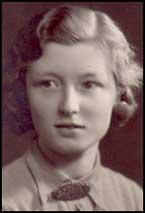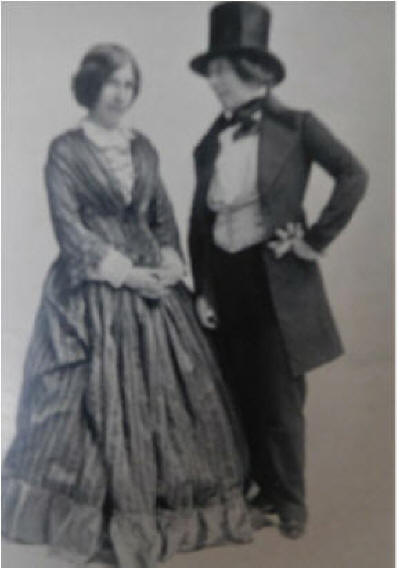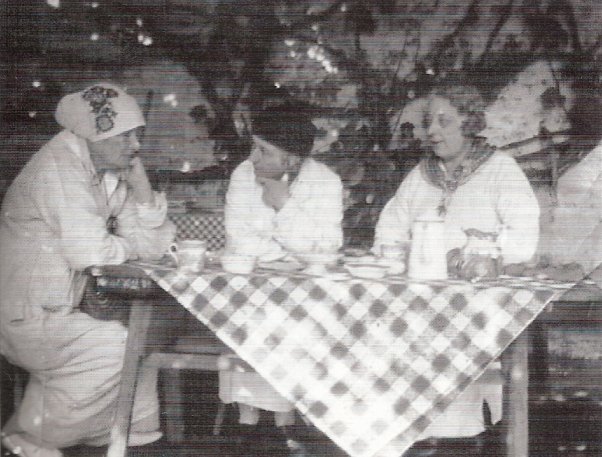

Partner Edith Craig and Clare Atwood, buried together
Queer Places:
(1901) Priest’s House, Smallhythe Rd,
Tenterden TN30 7NG, UK
(1906, 1913) 31 Bedford St, London WC2E 9ED, UK
(1928) Smallhythe, Smallhythe Rd, Tenterden TN30 7NG, UK
University of Oxford, Oxford, Oxfordshire OX1 3PA
7 Smith Square, Westminster, London SW1P 3HT, Regno Unito
St John the Baptist, Small Hythe, Tenterden TN30 7NF, Regno Unito
 Christabel
Gertrude Marshall (aka Christopher Marie St John) (24 October 1871 – 20
October 1960) was a British campaigner for women's suffrage, a playwright
and author.
Edith Craig lived
with
Christopher St. John for 48 years, from 1899 until Craig's death in 1947, with
Clare "Tony" Atwood
joining them from 1916.[2][3][4][5]
Edy Craig and
Christopher St. John were also active in the WSPU, committing militant
acts and contributing to propaganda through plays such as Votes for Women
(1909). Christopher St John (Christabel
Marshall) was a close friend of
Cicely Hamilton.
Christabel
Gertrude Marshall (aka Christopher Marie St John) (24 October 1871 – 20
October 1960) was a British campaigner for women's suffrage, a playwright
and author.
Edith Craig lived
with
Christopher St. John for 48 years, from 1899 until Craig's death in 1947, with
Clare "Tony" Atwood
joining them from 1916.[2][3][4][5]
Edy Craig and
Christopher St. John were also active in the WSPU, committing militant
acts and contributing to propaganda through plays such as Votes for Women
(1909). Christopher St John (Christabel
Marshall) was a close friend of
Cicely Hamilton.
Born in Exeter, she was the youngest of nine children of Emma Marshall, née Martin (1828–1899), novelist, and Hugh Graham Marshall (c.1825–1899), manager of the West of England Bank. She changed her name on her conversion to Catholicism in adulthood.[6] Having taken a BA in Modern History at Somerville College, Oxford, Marshall became the secretary to Mrs Humphry Ward, Lady Randolph Churchill and, occasionally, to her son Winston Churchill.
In order to pursue her aim of becoming a dramatist, Marshall went on the stage for three years to learn stagecraft, and occasionally acted as secretary to Ellen Terry. She lived with Terry's daughter Edith Craig from 1899 to Craig's death in 1947. They lived together at Smith Square and then 31 Bedford Street, Covent Garden as well as Priest's House, Tenterden, Kent.[7] Their relationship became temporarily strained when Craig received, and accepted, a marriage proposal from the composer Martin Shaw in 1903, and Marshall attempted suicide.[6] In 1916 Marshall and Craig were joined by the artist Clare 'Tony' Atwood, living in a ménage à trois until Craig died in 1947, according to Michael Holroyd in his book A Strange Eventful History.[2] In 1900 Marshall published her first novel, The Crimson Weed, which takes its title from a transformation of the traditional symbol of the red rose. A feminist, in 1909 she joined the Women's Social and Political Union (WSPU), having previously worked for the Women Writers' Suffrage League and the Actresses' Franchise League.[8]

Cicely Hamilton and
Christopher St John as George Eliot and George Sand, c. 1911

In 1909 Marshall turned Cicely Hamilton's short story How The Vote Was Won into a play that became popular with women's suffrage groups throughout the United Kingdom. Also in 1909, Marshall joined a WSPU deputation to the House of Commons of the United Kingdom, contributing an article Why I Went on the Deputation to the journal Votes for Women in July 1909. In November 1909 Marshall appeared as the woman-soldier Hannah Snell in Cicely Hamilton's Pageant of Great Women, directed by Edith Craig. With Hamilton she also wrote The Pot and the Kettle (1909), and with Charles Thursby,[9] The Coronation (1912). In May 1911 her play The First Actress was one of the three plays in the first production of Craig's theatre society, the Pioneer Players.[8] Marshall's plays Macrena and On the East Side were produced by the Pioneer Players, as well as her translation (with Marie Potapenko) of The Theatre of the Soul by Nikolai Evreinov.[10]
Radclyffe Hall and her lover, Una Troubridge, were close friends of Edy and the boys, and of Cicely Hamilton. There is something very moving about the photograph opposite in Hamilton’s autobiography of her and Christopher St John dressed as George Eliot and George Sand, respectively, for a fancy-dress ball in 1911. The past, when recovered, is replete with demonstrations that claiming citizenship is so much easier if you pretend to be a man.
Marshall converted to Catholicism in 1912 and took the name St John. She, Edith Craig and Clare Atwood were friends with many artists and writers including lesbian novelist Radclyffe Hall, who lived nearby in Rye.[7] As Christopher St John in 1915, she published her autobiographical novel Hungerheart, which she had started in 1899, and which she based on her relationship with Edith Craig and her own involvement in the women's suffrage movement. St John was contracted by Ellen Terry to assist on various publications. After Terry's death in 1928, St John published the Shaw–Terry Correspondence (1931) and Terry's Four Lectures on Shakespeare (1932). St John and Craig revised and edited Terry's Memoirs (1933).[11] After Edith Craig's death in 1947, St John and Atwood helped to keep the Ellen Terry Memorial Museum in operation. Some of St John's papers have survived in the National Trust's Ellen Terry and Edith Craig Archive.[12]
In 1932 St. John fell passionately in love with Vita Sackville-West; this caused huge rows between St. John and Craig, with Atwood unsuccessfully trying to act as peacemaker. The affair dragged on into 1934. Cicely Hamilton’s own closest friends in the suffrage network were Edy (Edith) Craig and Christopher St John (Christabel Marshall), who lived together, and then later in another 30-year-long ménage à trois with Tony (Clare) Atwood, a painter of some distinction, a trio known to their friends as ‘Edy and the boys’. The adopted male names were accompanied by masculine dress: ‘Miss Craig,’ wrote Virginia Woolf in her diary, ‘is a rosy, ruddy “personage” in white waistcoat, with black bow tie & gold chain loosely knotted.’ Virginia Woolf’s own lover, Vita Sackville-West, with whom St John was besotted, described Edy Craig as ‘the most tearing old lesbian’. She compared her to Radclyffe Hall, one half of the most celebrated public lesbian couple of the 20th century, and a famous masculine dresser.
Christopher St. John had a dual dedication, to Honor Bone and Marie Lawson, in her biography Christine Murrell M.D. (1935). Written at the request of Honor Bone, Christine Murrell's lover, the book acknowledge the fact that Murrell lived with two women, both of whom had loving significance for her. Dr Christine Murrell, about whom Christopher St. John wrote a biography, joined forces with her ‘beloved friend and colleague’ Dr Honor Bone early in her professional life and lived with her for over 30 years, the last of these spent in a ménage à trois with Marie Lawson, a printer, editor and tax resister. Murrell and Bone worked in general practice together in West London; Murrell, who also used the forename ‘Christopher’, ran one of the first infant welfare clinics, helped with the aftercare of imprisoned suffragettes and became the first woman elected to the Council of the British Medical Association in 1924 and to the General Medical Council in 1933.
Marshall died from pneumonia connected with heart disease at Tenterden in 1960. Marshall and Atwood are buried alongside each other at St John the Baptist's Church, Small Hythe. Craig's ashes were supposed to be buried there as well, but at the time of Marshall and Atwood's deaths, the ashes got lost and a memorial was placed in the cemetery instead.[13]
My published books: